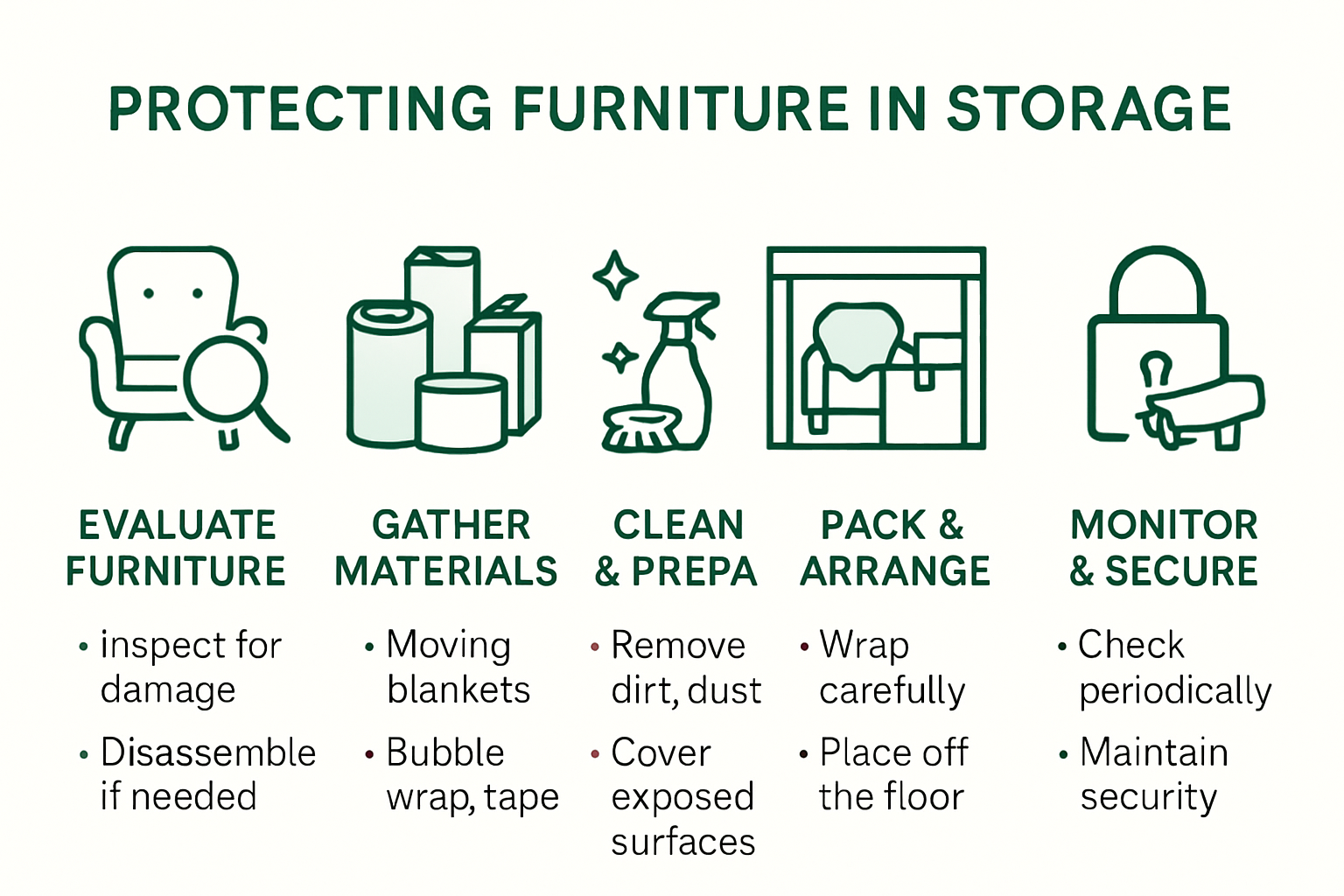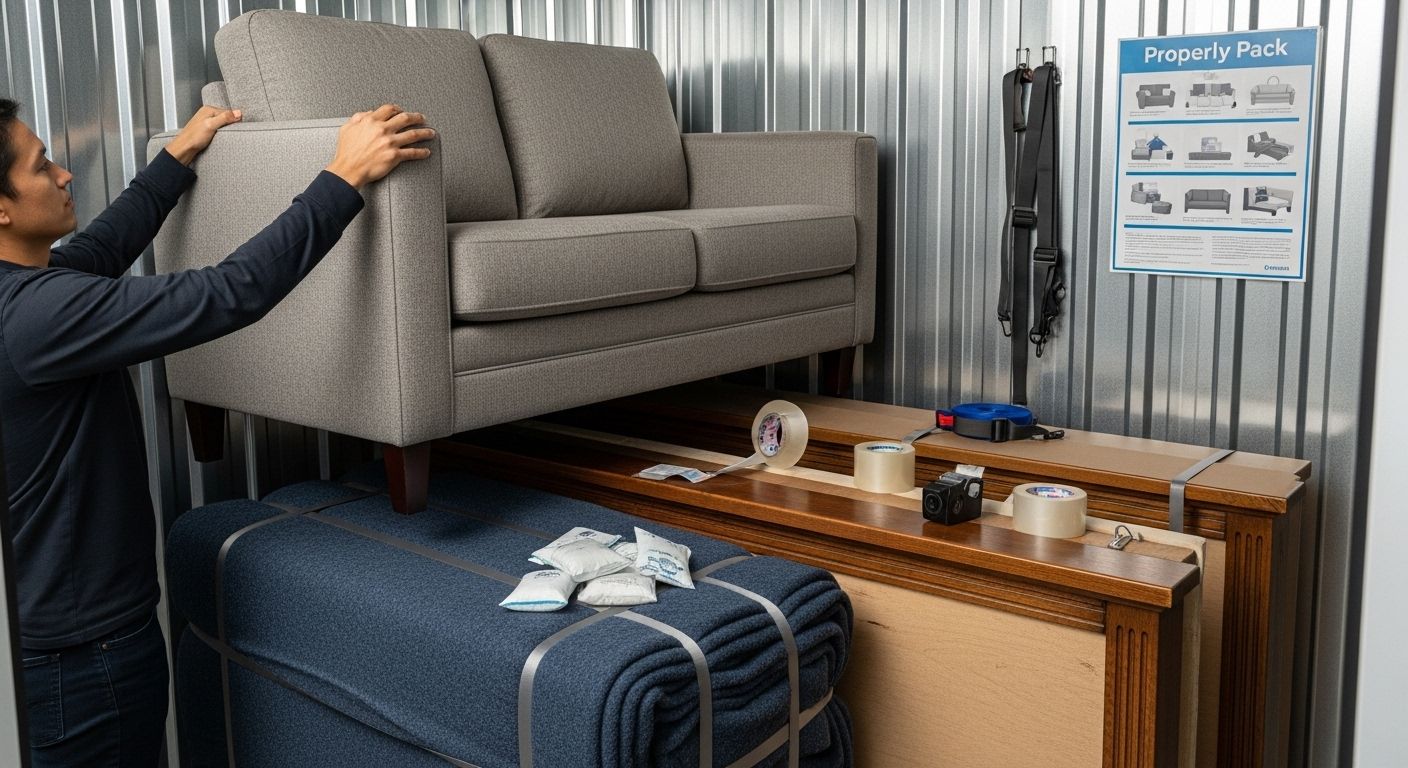Moving day has a funny way of turning even the calmest among us into sweaty, panicked chaos goblins. One minute you’re confidently taping boxes, and the next you’re wondering if your grandma’s antique dresser will survive the trip across town… or if it’s destined to become splinters on the freeway.
Packing furniture isn’t just about throwing a blanket over it and hoping for the best. Nope, it’s an art form, a strategic game of Tetris meets bubble wrap warfare. But don’t worry, this guide will walk you through the entire process, from prepping your pieces to loading them safely like the moving mastermind you were born to be.
Storing furniture might sound simple until you realize that wood, leather, and upholstery each face their own set of storage dangers. Turns out, damage often starts before you even close your storage unit door. Fragile or antique pieces demand extra care and specialized packing materials to prevent costly disasters. Most people miss these crucial details and end up with ruined furniture that could have been easily protected. Let’s save your back and your furniture, shall we?
Table of Contents
- Step 1: Evaluate Your Furniture Type And Needs
- Step 2: Gather Necessary Packing Materials
- Step 3: Clean And Prepare Furniture For Storage
- Step 4: Properly Pack And Arrange Furniture In Storage
- Step 5: Monitor Conditions And Secure The Storage Area
Quick Summary
| Key Point | Explanation |
|---|---|
| 1. Evaluate your furniture’s unique needs | Assess each piece’s material and condition to create a tailored protection strategy during storage. |
| 2. Gather high-quality packing supplies | Use protective materials like blankets and bubble wrap to shield furniture from damage and dust. |
| 3. Clean thoroughly before packing | Properly clean items to prevent pests and damage, ensuring they are dry and free of debris before storage. |
| 4. Use strategic packing and arrangement | Arrange heavier items at the bottom and use vertical space to optimize storage and protect furniture integrity. |
| 5. Monitor storage conditions regularly | Check climate levels and security measures to maintain furniture condition and prevent damage over time. |

Step 1: Evaluate Your Furniture Type and Needs
Successfully protecting furniture during storage begins with a meticulous evaluation of your specific items and their unique requirements. Not all furniture is created equal, and understanding the nuanced needs of each piece will determine your protection strategy. Wood, upholstery, antiques, and modern furniture demand different preservation approaches to maintain their condition and value.
Start by conducting a comprehensive visual and physical inspection of each furniture item. Look closely for existing damage such as loose joints, scratches, or weakened structural elements. Fragile or antique pieces require extra attention and potentially specialized packing materials. Take detailed notes about each item’s condition, noting any pre-existing wear or vulnerabilities that might need specific protection during storage.
Consider the material composition of your furniture as a critical factor in your storage protection plan. Wooden furniture, particularly those with intricate finishes or delicate veneers, will need different preparation compared to metal or synthetic materials. Learn more about protecting different furniture types to ensure comprehensive preservation. Leather and fabric upholstered items demand particular care to prevent moisture damage, mold growth, and fabric deterioration. Wooden furniture might require wood conditioners or protective waxes, while metal pieces could need rust-prevention treatments.
Measurement plays a crucial role in your evaluation process. Carefully measure each furniture piece to understand its dimensions, weight, and potential disassembly requirements. Some larger items like dining tables or bed frames might need partial disassembly to optimize storage space and reduce potential damage during transportation. Create a detailed inventory list that includes measurements, material type, current condition, and specific storage requirements for each piece.
Lastly, assess your overall storage needs by considering the anticipated storage duration, environmental conditions, and potential access requirements. Short-term storage might demand different preparation strategies compared to long-term preservation. Temperature fluctuations, humidity levels, and potential pest risks will significantly influence your protection approach. By thoroughly evaluating your furniture’s unique characteristics and storage context, you set the foundation for a successful furniture preservation strategy.
Step 2: Gather Necessary Packing Materials
Gathering the right packing materials is a critical step in protecting your furniture during storage. This preparation phase determines the level of protection your valuable items will receive, making it essential to select high-quality materials that match the specific needs of each piece. Professional movers and storage experts understand that investing in proper packing supplies can prevent costly damage and preserve furniture integrity.
Protective wrapping becomes your furniture’s first line of defense. Invest in high-quality moving blankets, furniture pads, bubble wrap, and stretch wrap to create multiple layers of protection. For wooden furniture, consider using specialized furniture blankets that provide cushioning and prevent scratches. Delicate antiques or pieces with intricate finishes require extra padding, so opt for thick moving blankets or custom-fit protective covers. Explore our expert packing recommendations to ensure comprehensive furniture protection.
The right boxes and containment materials can make a significant difference in your storage strategy. Sturdy plastic storage containers with secure lids work exceptionally well for smaller items and can protect against moisture and potential pest intrusion. For larger furniture pieces, consider purchasing specialty wardrobe boxes that allow hanging clothing or provide additional vertical storage space. Reinforce cardboard boxes with strong packing tape, ensuring all seams and edges are completely sealed to maintain structural integrity.
Additional essential materials include silica gel packets to absorb moisture, furniture disassembly tools like screwdrivers and wrenches, and protective corner guards for items prone to impact damage. Furniture straps and ratchet tie-downs can help secure larger pieces during transportation and prevent shifting in storage. Create a dedicated packing station with all materials within reach, including scissors, marker pens for labeling, and a tape dispenser. This preparation ensures a smooth and efficient packing process.
Before finalizing your materials, conduct a comprehensive inventory check. Verify you have sufficient quantities of each protective material, accounting for the number and size of furniture pieces you plan to store. A well-prepared approach minimizes last-minute rushes and reduces the potential for accidental damage during the packing and storage process.
To help you select the appropriate supplies, here is a table summarizing key packing materials, their uses, and what types of furniture they best protect:
| Material/Tool | Purpose | Best For |
|---|---|---|
| Moving blankets | Cushioning, scratch protection | Wood, antiques |
| Bubble wrap | Impact protection, shock absorption | Fragile items, glass |
| Stretch wrap | Securing protective layers | All furniture types |
| Plastic storage containers | Moisture/pest protection for small items | Small or disassembled pieces |
| Packing tape | Sealing boxes, securing wrappings | Boxes, wrapped surfaces |
| Silica gel packets | Absorbing moisture | Upholstery, wood, leather |
| Corner guards | Preventing corner impact damage | Tables, cabinets, frames |
| Furniture straps/tie-downs | Prevent shifting during transit/storage | Large/heavy pieces |
Step 3: Clean and Prepare Furniture for Storage
Cleaning and preparing furniture for storage is more than a simple dust-off task. This critical step protects your valuable items from potential damage, prevents pest infestations, and ensures your furniture remains in pristine condition during long-term storage. Thorough preparation can mean the difference between retrieving your furniture in the same condition you stored it and discovering unexpected deterioration.
Cleaning requires a strategic approach tailored to different furniture materials. For wooden furniture, use a soft microfiber cloth and a gentle wood cleaner that nourishes the wood without leaving residue. Avoid silicone-based polishes that can trap moisture and potentially damage the finish. Leather pieces demand special attention with a dedicated leather cleaner that conditions and protects the material, preventing cracking and maintaining its supple texture. Discover professional cleaning techniques for your storage preparation to maximize furniture preservation.
Before storage, completely disassemble furniture where possible. Remove drawers from dressers, take apart bed frames, and separate table legs. This not only saves storage space but also reduces the risk of structural damage during transportation and storage. Clean each disassembled piece individually, paying close attention to joints, crevices, and hard-to-reach areas where dust and moisture can accumulate. Wrap disassembled parts separately and label them clearly to ensure easy reassembly later.
Upholstered furniture requires a different cleaning approach. Vacuum thoroughly using appropriate attachments to remove dust, pet hair, and potential allergens. For fabric surfaces, use a specialized upholstery cleaner that is appropriate for the specific material. Allow these items to dry completely before storage to prevent mold and mildew growth. Consider using breathable furniture covers that protect against dust while allowing air circulation, which is crucial for preventing moisture buildup.
Finally, conduct a comprehensive final inspection. Check for any remaining dirt, ensure all surfaces are completely dry, and verify that each piece is properly prepared for storage. Minor repairs like tightening loose screws or addressing small scratches can prevent further damage during storage. By investing time in meticulous cleaning and preparation, you create a protective shield around your furniture, ensuring it remains in excellent condition throughout its storage journey.
Step 4: Properly Pack and Arrange Furniture in Storage
Packing and arranging furniture in storage transforms a potentially chaotic process into a strategic preservation mission. The goal is not just to fit everything into a confined space, but to create an environment that protects and maintains your furniture’s condition throughout its storage duration. Thoughtful arrangement minimizes potential damage and maximizes available storage space.
Weight distribution becomes your primary strategic consideration. Heavier items like solid wood dressers and large cabinets should form the foundation of your storage layout. Place these pieces first, creating a stable base for lighter furniture. Learn advanced techniques for optimizing storage space to ensure maximum protection and efficiency. Avoid stacking heavy items directly on top of delicate pieces to prevent structural compression and potential damage.
Protective wrapping serves as your furniture’s armor during storage. Wrap each piece completely, ensuring no exposed surfaces remain vulnerable. Use furniture blankets for wooden items, creating a protective layer against dust and potential scratches. Bubble wrap works exceptionally well for glass surfaces and fragile components. Secure wrappings with packing tape, but avoid direct tape contact with furniture surfaces to prevent finish damage. For upholstered furniture, use breathable protective covers that shield against dust while allowing air circulation, preventing moisture accumulation and potential mildew growth.
Vertical storage strategies can significantly optimize your space and furniture protection. Couches and mattresses should be stored on their sides to reduce floor contact and minimize potential sagging. Disassembled furniture pieces like table legs and bed frames can be stored vertically against walls, creating additional space and reducing the risk of accidental impact. Create clear pathways between stored items, allowing future access without navigating a complex furniture maze.
Before finalizing your storage arrangement, conduct a comprehensive inspection. Verify that each piece is stable, properly wrapped, and positioned to minimize potential damage. Leave small gaps between furniture items to promote air circulation and prevent potential moisture buildup. Consider using moisture-absorbing packets in your storage space to further protect against humidity-related damage. By approaching furniture storage with patience, strategy, and attention to detail, you create a protective environment that preserves your valuable items until they are ready to be retrieved.

Step 5: Monitor Conditions and Secure the Storage Area
Monitoring and securing your storage area represents the final critical phase in protecting your furniture investment. This step transforms a simple storage space into a carefully managed preservation environment, ensuring your valuable items remain in pristine condition throughout their storage duration. The right approach combines technological solutions, strategic planning, and consistent oversight.
Temperature and humidity control become your primary defense against potential furniture damage. Invest in a digital hygrometer to track humidity levels, aiming to maintain a consistent range between 30% and 50%. Extreme fluctuations can cause wood to expand, contract, or develop mold. Consider portable dehumidifiers or climate-controlled storage units that provide stable environmental conditions. Explore advanced storage protection strategies to safeguard your furniture against environmental threats.
Securing the storage area involves multiple layers of protection. Install robust locks on storage unit doors and consider additional security measures like motion-activated cameras or alarm systems. If storing at home, choose a location away from direct sunlight, external walls, and areas prone to temperature variations like garages or attics. Create a detailed inventory list with photographs of each furniture piece, which serves both documentation and insurance purposes. Regularly inspect your stored items, ideally every 4-6 weeks, to catch potential issues like pest infestations, moisture buildup, or developing structural weaknesses early.
Pest prevention requires proactive strategies. Use natural deterrents like cedar blocks, lavender sachets, or silica gel packets to discourage insects and moisture accumulation. Seal any potential entry points and consider placing rodent-prevention devices around the storage area. Avoid storing food items or cardboard boxes that might attract pests, as these can compromise your furniture’s safety. Elevate furniture slightly off the ground using pallets or moisture-resistant platforms to further protect against potential ground-level dampness or pest activity.
Final verification involves a comprehensive checklist. Confirm that all furniture is correctly positioned, wrapped, and protected. Ensure climate control systems are functioning, security measures are in place, and you have easy access to your stored items. By maintaining a vigilant and systematic approach to storage, you transform a simple storage space into a protective sanctuary for your valuable furniture, guaranteeing its preservation until you’re ready to retrieve and enjoy it once again.
Protect Your Furniture with Confidence: Choose Local Storage Solutions That Put You First
Struggling with stress over how to keep your furniture safe and damage-free in storage? From delicate wood finishes to bulky bed frames, you already know that poorly chosen packing materials, uncontrolled environments, and rushed organization can lead to lasting harm. You deserve a storage partner that understands just how much your furnishings mean to you and provides flexible support at every step. At Stomo, our weather-resistant portable storage containers are designed for South Carolina’s unique climate, allowing you to safeguard your furniture right at your own pace. Discover why so many trust our award-winning service and local expertise for everything from home renovations to emergency storage solutions. See our proven packing tips in action and pair them with our personalized moving and storage services.

Ready to keep your furniture secure, clean, and perfectly preserved until you need it again? Contact us now for a fast quote and find out why Stomo is South Carolina’s go-to choice for easy, family-owned portable storage and moving solutions. Your furniture deserves the best protection. Take control of your storage experience today at https://stomostorage.com.
Frequently Asked Questions
How do I evaluate my furniture’s needs before storage?
Conduct a thorough inspection of each piece, noting the material type, dimensions, and any existing damage. Consider the specific preservation needs of wood, fabric, and antiques to tailor your protection strategy.
What packing materials are essential for protecting furniture in storage?
Invest in high-quality moving blankets, bubble wrap, stretch wrap, and sturdy boxes. Silica gel packets for moisture control and protective corner guards are also beneficial for preventing damage.
How should I clean my furniture before storing it?
Use appropriate cleaners for each material; for wooden furniture, use a gentle wood cleaner and for upholstery, a specialized upholstery cleaner. Ensure all pieces are thoroughly dry to prevent mold and mildew.
What storage arrangement techniques help protect my furniture?
Place heavier items on the bottom during packing to ensure stability and avoid stacking heavy pieces on delicate ones. Use protective wrapping and leave space for air circulation to minimize damage during storage.
Recommended
- How to Pack a Storage Unit: Expert Guide for Every Need 2025 – STOMO Mobile Storage and MOVEMO Moving Service
- portable storage South Carolina
- Moving Portable Storage in South Carolina
- Moving insurance, restoration insurance, and renovation insurance
- How to Store Mattresses in Gauteng: Easy Guide for 2025 – Comfy Beds
- How to Move Heavy Furniture: UK and International Guide 2025 | Schott Removals
